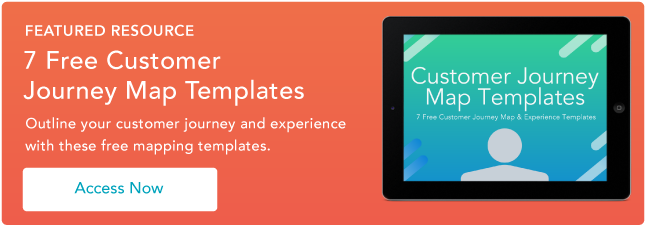When improving customer relations, we typically think about service and support rather than customer engagement. However, this goes beyond high-quality customer service. Delighting customers and encouraging them to spend more money with your brand isn't enough. In fact, this could make them feel transactional and less meaningful to your company.
Instead, you need to improve the customer experience to strengthen their loyalty to your brand through customer engagement. It needs to be clear that you value your relationship with your buyers and not just the money they spend. That's why you need to consistently engage with customers and demonstrate your dedication to their needs.
In this post, we'll discuss everything you need to know about customer engagement, including industry examples, software, tools, and how it can enhance customer relations in your organization.
Download Now: Free Customer Journey Map Templates
Customer Engagement
Customer engagement is the process of interacting with customers through a variety of channels in order to strengthen your relationship. For many businesses, this process begins with the first interaction and extends beyond the point of purchase. Companies can engage with customers via social media, email, websites, community forums, or any other space where they're communicating or consuming content.
The goal of customer engagement is to offer customers something of value beyond your products and services. High-quality products initially attract customers; relevant content is what keeps them around. Marketers do this through a strategy known as customer engagement marketing.
Customer Engagement Marketing
Customer engagement marketing is a marketing strategy that delivers timely, relevant, and personalized messages to consumers. What sets it apart from other marketing tactics is the personalization element. The relevancy of the content is what makes customers feel like engaged members of your brand's community.
Why Customer Engagement Marketing Works
You want your brand to be omnipresent so that no matter when your customer needs your help, your team is there. However, being omnipresent can become exhausting for even the largest organizations with resources to spend.
Customer engagement marketing works because it takes the pressure off of just one team to produce an exceptional customer experience. This type of strategy encompasses the entire customer journey and every team within your customer that supports it — from customer service, to operations, to sales.
How to Implement a Customer Engagement Marketing Strategy
To implement a viable customer engagement marketing strategy, you'll want to employ the following tactics:
1. Set a goal for successful customer engagement.
Any great strategy begins with a S.M.A.R.T. goal. Start setting your goals by thinking about why your business needs more customer engagement. It's easy to assume that you need it because engagement is good, but what exactly does that mean for your specific organization? Better yet, what's the benefit for the customer to engage with you? Figuring this out before your teams get started designing engagement campaigns will keep everyone within scope, on budget, and producing work that actually matters.
2. Begin cross-functional team collaboration.
As mentioned earlier, customer engagement isn't just one department's responsibility. In the early stages of this strategy, identify which teams have a part to play in engaging customers and get their buy-in. Not only is it easier to spread the workload across departments, but you'll also have a much more comprehensive strategy in the long run that truly serves the customer.
3. Identify where and how customers should engage in both the long and short term.
Later in this article, you'll learn more customer engagement strategies, and you'll see that not all of them will work during every phase of your campaign. Segmenting your efforts into short-term and long-term tactics will help you focus on the right deliverables at the right time. After all, your customers will want to engage with you on more than one occasion, on more than one platform.
4. Gather feedback from internal and external stakeholders as well as customers.
Once your campaign is live, review the goals you set in step number one. Track metrics that align with these goals so that you can monitor the success of your activities. Include internal stakeholder feedback from members of the cross-functional teams on the project as well as external partners who might be involved. Don't forget to gather feedback from the customers themselves so you can identify what's working and what needs work with enough time to make changes.
5. Iterate your customer engagement marketing strategy regularly.
You don't have to wait an entire year to iterate your customer engagement marketing strategy, especially if you have both short and long-term milestones for your customers to hit. Whether you decide to track progress weekly, monthly, or quarterly, stick to consistent intervals so you can easily measure it over time.
In addition to customer engagement marketing, there are a few other ways you can foster customer engagement. Let's take a look at those next.

Customer Engagement Strategies
- Build a brand voice.
- Share your brand voice online.
- Personalize customer experiences.
- Create content based on customer history.
- Use social media contests.
- Meet customers where they are.
- Use relationship marketing.
Based on this guide, it's clear that customer engagement positively impacts your business and ensures a stronger customer base. However, it's not so simple to just jump right in. Consider the following strategies for ways to incorporate customer engagement into your organization.
1. Build a brand voice.
Customers want to engage with a brand that has a personality. Many brands have differentiated themselves through the use of a unique brand voice. This personifies the company making it more relatable and memorable to its customers.
For instance, Glossier is an e-commerce makeup and skincare brand that stands out from competitors by donning a very playful, authentic personality. Women crave being a "Glossier Girl" — someone who embraces their authentic self and uses skincare and makeup as a means of highlighting their existing features, rather than disguising them with other beauty products.
Creating this brand voice establishes your company as a thought-leader in its industry. Customers will look at you as an expert who can give them advice on different products and services.
2. Share your brand voice online.
Your brand voice is more powerful when you share it with others. Start with building a personality on social media, just as you would with a personal account. Post content that aligns with your brand values and share messages that have similar meanings.
If you want your brand to have a more light-hearted personality, consider brands like Wendy's which embraces humor as a means of poking fun, like in the example below. Social media is a great way to engage with customers that may not have discovered or connected with your brand.

3. Personalize customer experiences.
Some companies, like Amazon, have software that makes recommendations based on past purchases or search history. Not every company has to invest in such complex technology. There are other ways to personalize customer experiences, including asking customers how you can help.
Some companies start the customer journey by asking them to fill out a user profile or take a quiz that has them select preferences. For instance, Birchbox asks customers what their skin and hair types are, which helps the company personalize products in their monthly subscription boxes. This way, you can obtain customer feedback at the beginning of the experience, then delight the customer from there.
4. Create content based on customer history.
Feedback surveys can help you create and share content based on what customers have purchased in the past. Unlike Birchbox, however, these suggestions aren't vital to the customer experience. Rather, they complement and add a special touch that exceeds your customers' expectations.
For instance, Spotify has a Discover Weekly playlist which is a playlist of songs that it creates for each user. The feature incorporates an algorithm that discovers each user's "taste profile" based on the songs they listen to and similar songs featured in other users' playlists. This campaign is a unique offering that shows how Spotify is helping users discover more music they might enjoy.
5. Use social media contests.
Cultivate customer engagement through friendly competition. The possibilities are endless when it comes to social media contests and giveaways, but no matter which route you choose, this type of activity can spark rapid customer engagement.
Beware that contests and giveaways can result in short-term engagement if they're not done strategically. To combat this, have a comprehensive plan for your social media engagement campaign that gives each customer a place to land long-term.
For example, if you have a new product or service, choose a long-term customer engagement strategy to promote it on — like YouTube. Then use your social media giveaway to drive engagement on your YouTube channel by asking customers to subscribe and watch videos about your new offerings.
6. Meet customers where they are.
An important part of a customer engagement strategy is to share relevant content in a place your customers will see it. That means posting the secret to business success on a billboard in the middle of the desert probably won't yield the engagement results you're looking for.
That's why it's important to meet your customers where they are — and social media isn't always the best way to do it. Sure, many of your customers can be found on Twitter, LinkedIn, and even TikTok, but they're probably on other channels too. When delighting your customers, you want to show up in the places they least expect you to be.
Explore options like:
- Murals in places with lots of foot traffic
- QR codes in and on modes of public transportation
- Holiday cards sent the old-fashioned way — in the mail
- Sponsorships on niche YouTube channels
7. Use relationship marketing.
Building relationships between your organization and your customers is a sure way to turn them into advocates of your brand. Relationship marketing is a strategy that can be used at any stage of your business. To implement this strategy effectively, you'll need to incentivize customer engagement. Tools like Rybbon can help you keep track of your outreach efforts and ensure that your customers are hitting the right engagement milestones throughout your campaign.
The use of customer engagement marketing strategies can make all the difference when it comes to reducing customer churn. In fact, let's take a look at a few companies that used this method to retain customers at their business.
Customer Engagement Examples
- Slack
- Coca-Cola
- Carhartt
- Gymshark
- Starbucks
- Gravity Payments
- Rybbon
Every brand has the potential to introduce engagement strategies that benefit its current and potential customer base. This is illustrated in the following examples, which include companies of various sizes and revenue.
1. Slack
For many professionals, Slack has become an integrated part of our lives during the work day, but sometimes we need the app on our mobile phones, too. Slack recognizes the importance of its software in its customers' lives — and how that software can contribute to an "always-on" culture.
In response, Slack shared this gentle reminder to customers who downloaded or updated the app.

What we like about Slack's customer engagement:
If you're anything like me, you're probably wondering "How did they know I needed to hear this right now?" While it's highly unlikely that the company's product team moonlights as mind readers, they are very attuned to their customers in order to spur engagement and interaction. Taking the opportunity to share a customer-centric message in a place they visit quite often is a recipe for delight and engagement.
2. Coca-Cola
As you may have seen, in 2014 Coca-Cola launched a new marketing campaign that took the nation by storm. #ShareACoke removed the company's logo on 20-ounce bottles and replaced it with 250 of the most common names in the U.S. The campaign was successful because of the customer engagement element.
What we like about Coca-Cola's customer engagement:
This wasn't just a typical marketing campaign; in fact, the highly personalized aspect made it even more engaging. Customers could physically see a piece of themselves on a Coke bottle. Even those without common names could follow the "Share A Coke" tour where they could personalize their own cans. This was a simple campaign that related to Coke's target audience and got people talking about the brand.
3. Carhartt
Carhartt, a work apparel company, introduced new technology to its website that helps customers connect with experts and make smarter purchases. When a customer displays a certain behavior, a pop-up appears that asks them if they'd like to chat with an expert.
It was found that when customers clicked "yes," they found the right product, were more satisfied with it, and purchased it again in the future. In fact, this led to a 10-fold increase in conversion rates compared to other self-service options, as well as a 10-25% increase in the average order value.
What we like about Carhartt's customer engagement:
Carhartt's customer engagement strategy proves that your business doesn't have to use the latest technology or even automated tools to provide an engaging customer experience. One-on-one interactions between your service team and the customer is still a viable strategy that can turn passive customers into brand enthusiasts.
4. Gymshark
Gymshark has grown its customer base exponentially through social media, guerrilla, and influencer marketing. The brand has a unique ability to reach its customers with highly personalized and relatable content that's sharable and interactive.

In this example, Gymshark joined the conversation about the gas shortage in the UK by setting up an interactive pumping station. This customer engagement campaign brings both prospective and existing customers face-to-face with the Gymshark brand to build relationships in a way that's authentic.
What we like about Gymshark's customer engagement:
Gymshark balances a serious concern of its UK customers (a gas shortage) with a positive outlet to blow some steam (a popup workout space). This customer engagement tactic is on brand and on time, showing its audience that the company is always listening and showing up when they need it most.
5. Starbucks
How does a company that's already dominating its industry do more for its customers? Well, it comes up with a way to make loyal customers feel special.
Starbucks began a new effort called the Starbucks Reserve Roastery and Tasting Room which lets customers chat with coffee specialists, watch coffee brew from fresh beans, and try a variety of rare coffees.
What we like about Starbucks' customer engagement:
This is a multi-sensory experience that takes customers to the next level. They feel like an active part of the Starbucks journey and are getting an inside look into the company's product development process. It's something exciting and unique that further engages customers and gives them a new appreciation for the brand beyond the same coffee every morning.
6. Gravity Payments
Sometimes, customer engagement can occur as a result of another initiative. After hearing about his employees' struggles, Dan Price, CEO of Gravity Payments, decided to implement a minimum annual salary of $70K. While the move was meant to improve employee satisfaction, productivity, and quality of life, the change also had a profound impact on customer engagement.
Monthly leads grew from 30 to 2,000 inquiries, profits doubled, and customer retention increased from 91% to 95%. It was clear that customer engagement was directly tied to employee satisfaction. When employees are treated better, they want to work harder for their companies, which results in happier customers.
What we like about Gravity Payment's customer engagement:
While these are great success stories, it can be hard to predict whether an engagement marketing campaign will be effective. Investing in an engagement platform, however, can ensure your campaigns will be consistently profitable for your business.
7. Rybbon
Rybbon walks the walk when it comes to customer engagement. This tool is used by thousands of businesses to manage customer engagement through reward programs, surveys, incentives, and more. But their commitment to the customer doesn't stop when their businesses are onboarded to its platform. The team at Rybbon is committed to engaging their own customers who use its platform, too.
What we like about Rybbon's customer engagement:
In a case study about biotech company Quincy Bioscience, one person said, “It’s been highly successful, we’ve captured thousands of leads, and the conversion rates are very high, almost everyone who receives the module completes it. We’re huge advocates of the platform.”

And that's the goal of customer engagement — to cultivate brand advocacy in your customer base.
Now that you understand the basics of customer engagement, how to use customer engagement marketing in your campaigns, and you've seen some examples of companies that are doing it well, try it on your own. Follow the tactics in this article to build a customer experience that will keep your brand top of mind for new and existing customers.
Editor's note: This post was originally published in July 2019 and has been updated for comprehensiveness.
Customer Experience






![Is The Customer Always Right? [What It Means + Why It Matters]](https://53.fs1.hubspotusercontent-na1.net/hubfs/53/customer-is-always-right-origin-1-20250202-6448090.webp)





